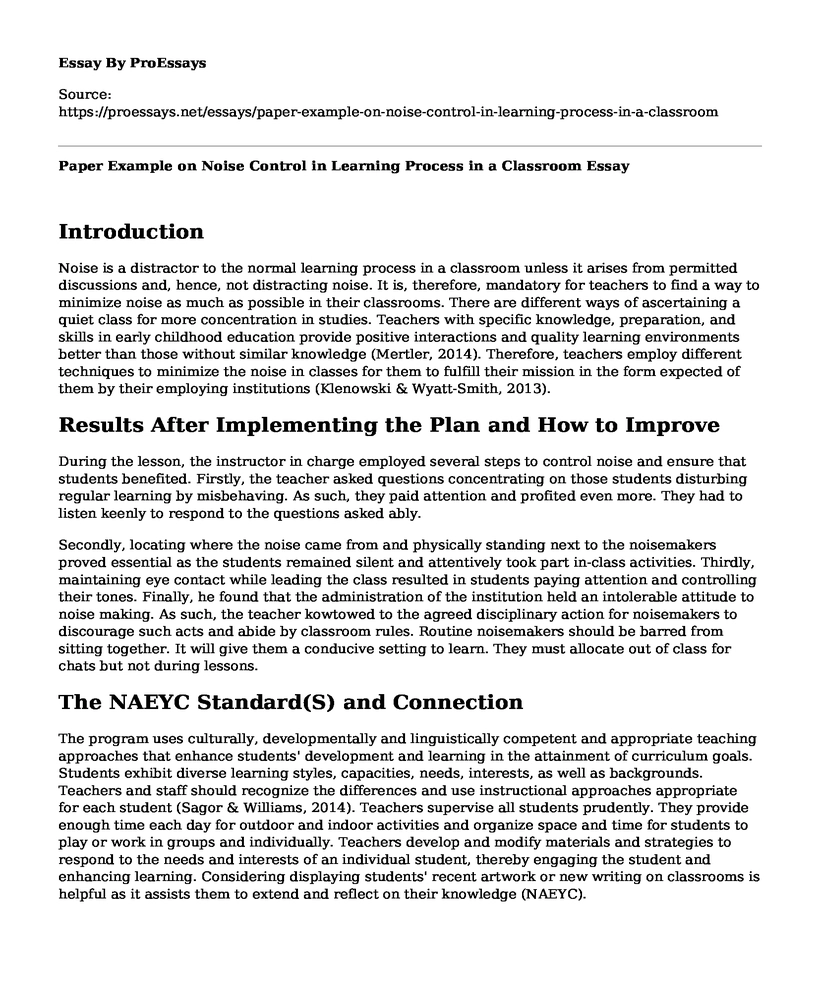Introduction
Noise is a distractor to the normal learning process in a classroom unless it arises from permitted discussions and, hence, not distracting noise. It is, therefore, mandatory for teachers to find a way to minimize noise as much as possible in their classrooms. There are different ways of ascertaining a quiet class for more concentration in studies. Teachers with specific knowledge, preparation, and skills in early childhood education provide positive interactions and quality learning environments better than those without similar knowledge (Mertler, 2014). Therefore, teachers employ different techniques to minimize the noise in classes for them to fulfill their mission in the form expected of them by their employing institutions (Klenowski & Wyatt-Smith, 2013).
Results After Implementing the Plan and How to Improve
During the lesson, the instructor in charge employed several steps to control noise and ensure that students benefited. Firstly, the teacher asked questions concentrating on those students disturbing regular learning by misbehaving. As such, they paid attention and profited even more. They had to listen keenly to respond to the questions asked ably.
Secondly, locating where the noise came from and physically standing next to the noisemakers proved essential as the students remained silent and attentively took part in-class activities. Thirdly, maintaining eye contact while leading the class resulted in students paying attention and controlling their tones. Finally, he found that the administration of the institution held an intolerable attitude to noise making. As such, the teacher kowtowed to the agreed disciplinary action for noisemakers to discourage such acts and abide by classroom rules. Routine noisemakers should be barred from sitting together. It will give them a conducive setting to learn. They must allocate out of class for chats but not during lessons.
The NAEYC Standard(S) and Connection
The program uses culturally, developmentally and linguistically competent and appropriate teaching approaches that enhance students' development and learning in the attainment of curriculum goals. Students exhibit diverse learning styles, capacities, needs, interests, as well as backgrounds. Teachers and staff should recognize the differences and use instructional approaches appropriate for each student (Sagor & Williams, 2014). Teachers supervise all students prudently. They provide enough time each day for outdoor and indoor activities and organize space and time for students to play or work in groups and individually. Teachers develop and modify materials and strategies to respond to the needs and interests of an individual student, thereby engaging the student and enhancing learning. Considering displaying students' recent artwork or new writing on classrooms is helpful as it assists them to extend and reflect on their knowledge (NAEYC).
Learning from The Experience and The Course
Noise control not only makes it easier for teachers to concentrate on essential aspects of their mission but also create improved learning conditions for students. Students have to recognize the relationship between noise and learning outcomes, and since they are often the ones (as a group) who make noise, they have to learn how to behave. Noise contributes to making education institutions unable to fulfill their mission as expected of them (Mertler, 2014). Noise control aids in the provision of an environment not only for the teacher to learn but also for the teacher to teach effectively to meet laid out objectives, mission, and goals. Further, it accords all students equal chances to both excel and imbibe the grasped knowledge during lessons.
References
Klenowski, V., & Wyatt-Smith, C. M. (2013). Assessment for Education: Standards, Judgement and Moderation.
Mertler, C. A. (2014). Action research: Improving schools and empowering educators. Los Angeles: SAGE.
NAEYC. (n.d.). The 10 NAEYC program standards, Naeyc. Retrieved from https://www.naeyc.org/our-work/families/10-naeyc-program-standards
Sagor, R. D., & Williams, C. D. V. (2016). The Action Research Guidebook: A Process for Pursuing Equity and Excellence in Education.
Cite this page
Paper Example on Noise Control in Learning Process in a Classroom. (2022, Apr 19). Retrieved from https://proessays.net/essays/paper-example-on-noise-control-in-learning-process-in-a-classroom
If you are the original author of this essay and no longer wish to have it published on the ProEssays website, please click below to request its removal:
- Reflection Essay Example
- Promoting Health and Wellness in Children Essay
- Essay on Lessons from Preschool Observation
- The Transition From Middle School to High School Essay
- Essay Sample on Life Experience
- Causes of University Fresh Graduates to Obtain a Job in Malaysia Paper Example
- Paper Sample on CTSOs Offer Career Opportunities in Banking Services for Students







